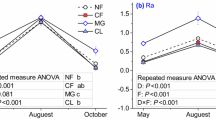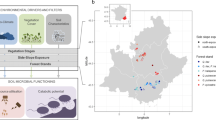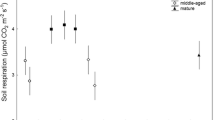Abstract
Purpose
Understanding the ability of ecosystem processes to resist to and to recover from disturbances is critical to sustainable land use. However, the spatial variability of the stability has rarely been addressed. Here, we investigated the functional stability of a soil microbial process for 24 soils collected from adjacent locations from a 0.3 ha tropical rainforest plot in Paracou, French Guiana.
Materials and methods
The 24 locations were characterized regarding soil chemical and biological (microbial diversity) parameters and forest structure. The corresponding soils were submitted to an experimental transient heat disturbance during a microcosm experiment. The response of the respiration process was followed using substrate-induced respiration (SIR).
Results and discussion
The response of soil SIR to heat disturbance varied widely between samples. The variability of the SIR response increased just after the disturbance, and a global rather homogeneous decrease in SIR rates was observed 15 and 30 days after. The stability of SIR in response to heat disturbance could not be related to either the genetic or the metabolic diversity of the microbial community. The initial level of SIR before the disturbance was the soil variable that best correlated with the impact of the disturbance: the soil locations with the highest initial SIR rates were the most affected 15 and 30 days after the heat disturbance.
Conclusions
Such a heterogeneous response suggests that the response of soil processes to a disturbance will be difficult to assess from only local-scale analyses and highlights the need for spatial explicitness in understanding biogeochemical processes.


Similar content being viewed by others
References
Allison SD, Martiny JBH (2008) Resistance, resilience, and redundancy in microbial communities. Proc Natl Acad Sci U S A 105:11512–11519
Banning NC, Murphy DV (2008) Effect of heat-induced disturbance on microbial biomass and activity in forest soil and the relationship between disturbance effects and microbial community structure. Appl Soil Ecol 40:109–119
Barthes BG, Brunet D, Brauman A, Fromin N, Lensi R, Volant A, Laclau JP, Blavet D, Chapuis-Lardy L (2010) Determination of potential denitrification in a range of tropical topsoils using near infrared reflectance spectroscopy (NIRS). Appl Soil Ecol 46:81–89
Bottner P (1985) Response of microbial biomass to alternate moist and dry conditions in a soil incubated with C-14-labelled and N-15-labelled plant material. Soil Biol Biochem 17:329–337
Brown BL (2007) Habitat heterogeneity and disturbance influence patterns of community temporal variability in a small temperate stream. Hydrobiologia 586:93–106
de Boer W, Verheggen P, Gunnewiek P, Kowalchuk GA, van Veen JA (2003) Microbial community composition affects soil fungistasis. Appl Environ Microbiol 69:835–844
Degens BP, Schipper LA, Sparling GP, Duncan LC (2001) Is the microbial community in a soil with reduced catabolic diversity less resistant to stress or disturbance? Soil Biol Biochem 33:1143–1153
Donnelly SM, Kramer A (1999) Testing for multiple species in fossil samples: an evaluation and comparison of tests for equal relative variation. Am J Phys Anthropol 108:507–529
Ettema CH, Wardle DA (2002) Spatial soil ecology. Trends Ecol Evol 17:177–183
Fanin N, Barantal S, Hättenschwiler S, Schimann H, Fromin N (2011) Does variability in litter quality determine soil microbial respiration in a Amazonian rainforest? Soil Biol Biochem 43:1014–1022
Gessner MO, Inchausti P, Persson L, Raffaelli DG, Giller PS (2004) Biodiversity effects on ecosystem functioning: insights from aquatic systems. Oikos 104:419–422
Giller PS, Hillebrand H, Berninger UG, Gessner MO, Hawkins S, Inchausti P, Inglis C, Leslie H, Malmqvist B, Monaghan MT, Morin PJ, O'Mullan G (2004) Biodiversity effects on ecosystem functioning: emerging issues and their experimental test in aquatic environments. Oikos 104:423–436
Girvan MS, Campbell CD, Killham K, Prosser JI, Glover LA (2005) Bacterial diversity promotes community stability and functional resilience after perturbation. Environ Microbiol 7:301–313
Gourlet-Fleury S, Houllier F (2000) Modelling diameter increment in a lowland evergreen rain forest in French Guiana. Forest Ecol Manag 131:269–289
Griffiths BS, Ritz K, Bardgett RD, Cook R, Christensen S, Ekelund F, Sørensen S, Bååth S, Bloem J, de Ruiter PC, Dolfing J, Nicolardot B (2000) Ecosystem response of pasture soil communities to fumigation-induced microbial diversity reductions: an examination of the biodiversity–ecosystem function relationship. Oikos 90:279–294
Griffiths BS, Ritz K, Wheatley R, Kuan HL, Boag B, Christensen S, Ekelund F, Sørensen SJ, Muller S, Bloem J (2001) An examination of the biodiversity–ecosystem function relationship in arable soil microbial communities. Soil Biol Biochem 33:1713–1722
Griffiths BS, Kuan HL, Ritz K, Glover LA, McCaig AE, Fenwick C (2004) The relationship between microbial community structure and functional stability, tested experimentally in an upland pasture soil. Microb Ecol 47:104–113
Griffiths BS, Hallett PD, Kuan HL, Gregory AS, Watts CW, Whitmore AP (2008) Functional resilience of soil microbial communities depends on both soil structure and microbial community composition. Biol Fertil Soils 44:745–754
Hooper DU, Bignell DE, Brown VK, Brussaard L, Dangerfield JM, Wall DH, Wardle DA, Coleman DC, Giller KE, Lavelle P, van der Putten WH, de Ruiter PC, Rusek J, Silver WL, Tiedje JM, Wolters V (2000) Interactions between aboveground and belowground biodiversity in terrestrial ecosystems: patterns, mechanisms, and feedbacks. BioScience 50:1049–1061
Jossi M, Fromin N, Tarnawski S, Kohler F, Gillet F, Aragno M, Hamelin J (2006) How elevated pCO2 modifies total and metabolically active bacterial communities in the rhizosphere of two perennial grasses grown under field conditions. FEMS Microbiol Ecol 55:339–350
Katayama A, Kume T, Komatsu H, Ohashi M, Nakagawa M, Yamashita M, Otsuki K, Suzuki M, Kumagai T (2009) Effect of forest structure on the spatial variation in soil respiration in a Bornean tropical rainforest. Agr Forest Meteorol 149:1666–1673
Kuan HL, Hallett PD, Griffiths BS, Gregory AS, Watts CW, Whitmore AP (2007) The biological and physical stability and resilience of a selection of Scottish soils to stresses. Eur J Soil Sci 58:811–821
Kühlmann S, Hjorth U (2007) Accounting for large-scale factors in the study of understory vegetation using a conditional logistic model. Environ Ecol Stat 14:149–159
Kuuluvainen T, Pukkala T (1989) Effect of Scots pine seed trees on the density of ground vegetation and tree seedlings. Silva Fenn 23:159–167
Lewis SL, Phillips OL, Baker TR, Lloyd J, Malhi Y, Almeida S, Higuchi N, Laurance WF, Neill DA, Silva JNM, Terborgh J, Lezama AT, Martinez RV, Brown S, Chave J, Kuebler C, Vargas PN, Vinceti B (2004) Concerted changes in tropical forest structure and dynamics: evidence from 50 South American long-term plots. Philos Trans R Soc B-Biol Sci 359:421–436
McClain ME, Boyer EW, Dent L, Gergel SE, Grimm NB, Groffman PM, Hart SC, Harvey JW, Johnston CA, Mayorga E, McDowell WH, Pinay G (2003) Biogeochemical hot spots and hot moments at the interface of terrestrial and aquatic ecosystems. Ecosystems 6:301–312
McGill BM, Sutton-Grier AE, Wright JP (2010) Plant trait diversity buffers variability in denitrification potential over changes in season and soil conditions. PLoS One 5:e11618
Michelland R, Monteils V, Zened A, Combes S, Cauquil L, Gidenne T, Hamelin J, Fortun-Lamothe L (2009) Bacterial communities of the bovine rumen and feces and relationship with ruminal parameters. J Appl Microbiol 107:1642–1650
Milcu A, Thebault E, Scheu S, Eisenhauer N (2010) Plant diversity enhances the reliability of belowground processes. Soil Biol Biochem 42:2102–2110
Morin PJ, McGrady-Steed J (2004) Biodiversity and ecosystem functioning in aquatic microbial systems: a new analysis of temporal variation and species richness–predictability relations. Oikos 104:458–466
Naeem S, Li SB (1997) Biodiversity enhances ecosystem reliability. Nature 390:507–509
Nannipieri P, Ascher J, Ceccherini MT, Landi L, Pietramellara G, Renella G (2003) Microbial diversity and soil functions. Eur J Soil Sci 54:655–670
Orwin KH, Wardle DA (2005) Plant species composition effects on belowground properties and the resistance and resilience of the soil microflora to a drying disturbance. Plant Soil 278:205–221
Pinay G, Barbera P, Carreras-Palou A, Fromin N, Sonié L, Coûteaux M-M, Roy J, Philippot L, Lensi R (2007) Impact of atmospheric CO2 concentration and vegetation plant life forms on soil microbial activities. Soil Biol Biochem 39:33–42
Ranjard L, Richaume A (2001) Quantitative and qualitative microscale distribution of bacteria in soil. Res Microbiol 152:707–716
Schimann H, Joffre R, Roggy J-C, Lensi R, Domenach A-M (2007) Evaluation of the recovery of microbial functions during soil restoration using near infra-red spectroscopy. Appl Soil Ecol 37:223–232
Seybold CA, Herrick JE, Brejda JJ (1999) Soil resilience: a fundamental component of soil quality. Soil Sci 164:224–234
Sodhi NS (2008) Invited views in basic and applied ecology—tropical biodiversity loss and people—a brief review. Basic Appl Ecol 9:93–99
Strickland MS, Lauber C, Fierer N, Bradford MA (2009) Testing the functional significance of microbial community composition. Ecology 90:441–451
Tilman D, Reich PB, Knops JMH (2006) Biodiversity and ecosystem stability in a decade-long grassland experiment. Nature 441:629–632
van Haren JLM, de Oliveira RC, Restrepo-Coupe N, Hutyra L, de Camargo PB, Keller M, Saleska SR (2010) Do plant species influence soil CO2 and N2O fluxes in a diverse tropical forest? J Geophys Res 115:GO 3010
Wardle DA, Ghani A (1995) A critique of the microbial metabolic quotient (qCO2) as a bioindicator of disturbance and ecosystem development. Soil Biol Biochem 27:1601–1610
Wardle DA, Bonner KI, Barker GM (2000) Stability of ecosystem properties in response to above-ground functional group richness and composition. Oikos 89:11–23
Weigelt A, Schumacher J, Roscher C, Schmid B (2008) Does biodiversity increase spatial stability in plant community biomass? Ecol Lett 11:338–347
Wertz S, Degrange V, Prosser JI, Poly F, Commeaux C, Guillaumaud N, Le Roux X (2007) Decline of soil microbial diversity does not influence the resistance and resilience of key soil microbial functional groups following a model disturbance. Environ Microbiol 9:2211–2219
Wittebolle L, Marzorati M, Clement L, Balloi A, Daffonchio D, Heylen K, De Vos P, Verstraete W, Boon N (2009) Initial community evenness favours functionality under selective stress. Nature 458:623–626
Yachi S, Loreau M (1999) Biodiversity and ecosystem productivity in a fluctuating environment: the insurance hypothesis. Proc Natl Acad Sci U S A 96:1463–1468
Zemb O, Haegeman B, Delgenes JP, Lebaron P, Godon JJ (2007) SAFUM: statistical analysis of SSCP fingerprints using PCA projections, dendrograms and diversity estimators. Mol Ecol Notes 7:767–770
Acknowledgments
This work was supported by ACI/Ecosphère Continentale, Fonctionnement et Dynamique de la Biosphère Continentale: Processus, Echanges de Matières et d’Energie, Modélisation (Centre National de la Recherche Scientifique, France) program DIPROTROFLUX (coordination J. Roy and A.-M. Domenach), and by “Fonds de Coopération Régional Guyane” (coordination J.C. Roggy). Laboratory analyses were performed at the “Plate-forme d’Analyses Chimiques en Ecologie”, platform of the Institut Fédératif de Recherche “Montpellier Environnement Biodiversité”, in Montpellier. We would like to thank Christophe Escape (UMR CEFE 5175, Montpellier) for microcosm conditioning, Didier Brunet (UMR Eco&Sols, Montpellier) for NIRS analyses, and Marjolaine Hamelin for editing.
Author information
Authors and Affiliations
Corresponding author
Additional information
Responsible editor: Weixin Cheng
Rights and permissions
About this article
Cite this article
Fromin, N., Porte, B., Lensi, R. et al. Spatial variability of the functional stability of microbial respiration process: a microcosm study using tropical forest soil. J Soils Sediments 12, 1030–1039 (2012). https://doi.org/10.1007/s11368-012-0528-7
Received:
Accepted:
Published:
Issue Date:
DOI: https://doi.org/10.1007/s11368-012-0528-7




